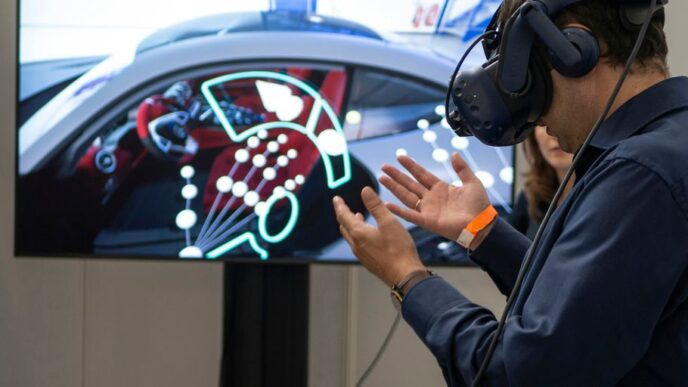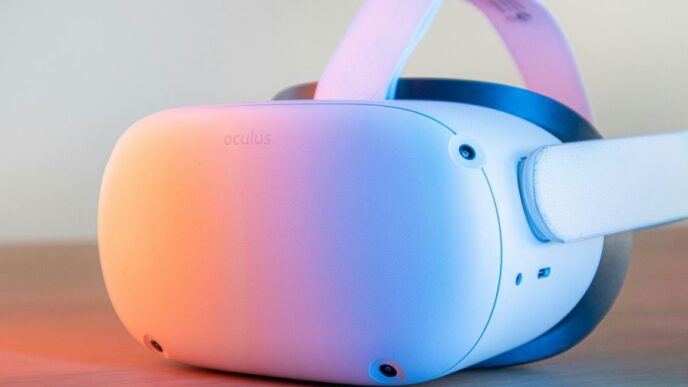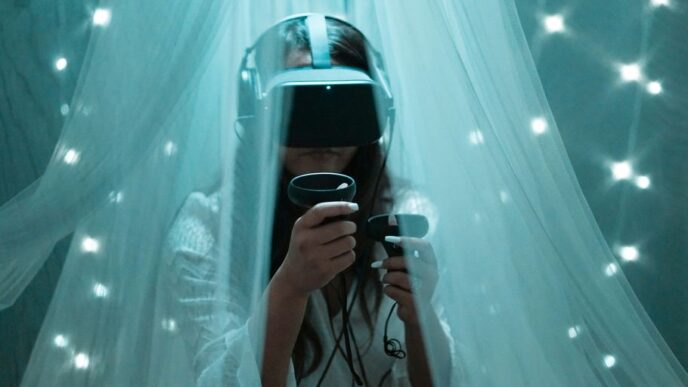Remember when newspapers were just, well, paper? Flipping through pages, maybe doing the crossword. Pretty simple stuff. But things are changing, and fast. Now, with augmented reality newspaper experiences, those static pages are coming alive. It’s like something out of a sci-fi movie, but it’s happening right now. This isn’t just about cool tech; it’s about making reading way more interesting and giving old-school print a fresh new twist. Get ready to see how your morning paper might just surprise you.
Key Takeaways
- Augmented reality is making print media way more interactive, connecting the old-school paper with digital stuff.
- This new tech means print can offer cool, immersive content, making reading a whole new experience.
- AR helps newspapers find new ways to make money and makes ads more fun to look at.
- Big names like The New York Times and National Geographic are already using augmented reality to tell stories in fresh ways.
- Even with some hurdles, augmented reality is set to keep changing how we read and interact with print, especially as AR glasses get better.
The Evolution of Augmented Reality Newspaper Experiences
The Emergence of Augmented Reality
Okay, so augmented reality (AR) is kinda a big deal now, right? But it’s not like it popped up overnight. The idea’s been kicking around for a while. Basically, AR is when you slap digital stuff over the real world, making it seem like they’re hanging out together. Think Pokemon Go, but for, like, newspapers. Back in the early 90s, some Boeing researcher, Tom Caudell, coined the term while working on wiring stuff for airplanes. Who knew augmented reality’s origins were in aerospace?
Early Applications in Print Media
Fast forward to the early 2000s, and suddenly everyone’s got a smartphone. That’s when AR started creeping into magazines and newspapers. Remember those weird QR codes? Yeah, those were early attempts at AR. You’d scan one, and it would take you to a website or something. It wasn’t super slick, but it was a start. Magazines started doing things like letting you see extra photos or videos when you scanned a page. It was all about trying to bridge the gap between paper and the internet. It was a pretty cool way to engage readers back then.
Augmented Reality Transforming Print Journalism
These days, AR is way more advanced. We’re talking about 3D models popping out of the page, interactive games, and all sorts of crazy stuff. Publishers are trying to find new ways to make print media exciting again. It’s not just about reading words on a page anymore; it’s about creating an experience. Think about scanning an article about a new car and being able to see a 3D model of it right there on your coffee table. Or scanning a recipe and having a video pop up showing you how to make it. The possibilities are pretty endless. It’s a total game-changer for print journalism, making it more interactive and engaging than ever before.
Enhancing the Reading Experience with Augmented Reality Newspaper
Bridging the Gap between Print and Digital Media
Okay, so, newspapers are kind of old school, right? But what if you could make them, like, not old school? That’s where augmented reality comes in. It’s like giving your newspaper a superpower. AR acts as a bridge, connecting the tangible feel of print with the interactive world of digital. Think of it this way: you’re reading an article about a new phone, and suddenly, you can see a 3D model of it right there on the page. It’s not just reading anymore; it’s experiencing. This is how augmented reality is changing things.
Interactive and Immersive Content
Imagine reading an article about a historical event, and then, bam, you can watch a video clip from that time right on the page. Or maybe you’re reading about a sports game, and you can see instant replays. That’s the power of interactive content. It’s not just about reading words; it’s about seeing, hearing, and interacting with the news. It makes the whole experience way more engaging. It’s like turning your newspaper into a mini-movie screen. I think that’s pretty cool. Here’s a quick rundown of what AR can bring:
- Videos that pop up right on the page.
- 3D models you can spin around and check out.
- Interactive infographics that let you explore data.
Personalized News Consumption
What if your newspaper knew what you were interested in? With augmented reality, it can. Imagine scanning an article and getting extra content tailored just for you. Maybe you’re really into cooking, so you scan a food article and get a recipe video. Or you’re a sports fan, so you scan a game recap and get player stats. It’s all about making the news more relevant and interesting to you. It’s like having a personal news assistant built right into your newspaper. It’s all about making the news more relevant and interesting to you.
Augmented Reality Newspaper in Education and Beyond
Augmented Reality Revolutionizing Print Education
Augmented reality is changing how students learn. It’s making textbooks and other materials more interactive and engaging. Imagine a history textbook where scanning a page brings up a 3D model of an ancient artifact or a video reenactment of a historical event. It’s not just about making things look cool; it’s about helping students understand and remember information better. AR can bring abstract concepts to life, making learning more hands-on and less like memorizing facts from a page. Think about exploring a digital sculpture in AR, learning about its history, and interacting with virtual objects from the classroom. This approach fosters curiosity and a deeper connection with the subject matter.
Real-Time Updates and Interactive Elements
One of the coolest things about AR is its ability to provide real-time updates. A science textbook could show the current weather patterns or display live data from an experiment. This keeps the information fresh and relevant, unlike traditional textbooks that can quickly become outdated. Plus, interactive elements like quizzes and simulations can be embedded directly into the pages, allowing students to test their knowledge and get immediate feedback. It’s like having a personal tutor built into the book. Newspapers have started incorporating augmented reality to provide multimedia content. This integration of AR in newspapers adds value to the print product and attracts a younger audience.
Future Implications of Augmented Reality Newspaper
Looking ahead, the possibilities for AR in education are huge. We might see a shift away from physical textbooks altogether, with students accessing AR-enabled content through devices or even AR glasses. This would allow for personalized learning experiences tailored to each student’s needs and preferences. Imagine a math textbook that adapts to your skill level, providing extra help where you need it and challenging you when you’re ready for more. The future of augmented reality in print media is vast, with advancements in technology promising even more sophisticated and seamless experiences. Here’s a quick look at how things might change:
- Personalized Learning: Content adapts to individual student needs.
- Interactive Assessments: Real-time feedback and progress tracking.
- Immersive Experiences: Virtual field trips and simulations.
Augmented Reality Newspaper in Advertising and Revenue
Augmented Reality Enhancing Print Advertising
Traditional print advertising has faced challenges in capturing consumer attention in the digital age. However, augmented reality is breathing new life into print ads by making them interactive. AR allows advertisers to create engaging experiences that capture attention and encourage interaction. Imagine scanning an ad in a magazine and instantly seeing a 3D model of the product or a video demonstration. This not only grabs the reader’s attention but also encourages them to spend more time engaging with the publication. It’s a win-win!
New Revenue Streams for Publishers
AR opens up new revenue streams for publishers. Instead of relying solely on traditional ad sales, publishers can partner with AR technology companies to create unique experiences for advertisers. This could involve developing custom AR apps or integrating AR features directly into their existing platforms. Publishers can also offer premium AR advertising packages that command higher prices. For example, a fashion magazine could use AR to offer readers personalized styling suggestions based on their body type and fashion preferences. This level of personalization not only enhances the reader’s experience but also increases the effectiveness of advertising campaigns. By delivering relevant and tailored content, advertisers can achieve higher conversion rates and return on investment.
Interactive Advertisements
AR transforms static print ads into interactive experiences. Readers can scan an ad with their smartphone or tablet to unlock additional content, such as videos, animations, or even games. This not only makes the ad more engaging but also provides valuable data to advertisers about how users are interacting with their campaigns. Here are some examples of interactive AR advertisements:
- Virtual Try-On: Customers can virtually try on clothes or makeup using their smartphone’s camera.
- 3D Product Visualization: Potential buyers can view a 3D model of a product in their own home before making a purchase.
- Interactive Games: Ads can include mini-games that users can play to win discounts or prizes.
These interactive elements not only capture the user’s attention but also provide a more memorable and engaging experience, leading to increased brand awareness and sales. AR is not only enhancing print advertising but also transforming the way print journalism is presented and consumed. Traditional print media outlets are leveraging AR technology to provide readers with a more interactive and immersive news experience.
Case Studies of Augmented Reality Newspaper Success
The New York Times’ Augmented Reality Journalism
The New York Times has really been at the forefront of using augmented reality to make their journalism better. They’ve got an AR app that lets them bring stories to life by putting digital stuff on top of real-world scenes. One cool example was their coverage of the 2018 Winter Olympics. You could use the app to check out 3D models of the Olympic venues, watch athletes do their thing, and even feel like you were skiing down a virtual slope. It was a pretty immersive way to get into the news, making it more interactive and personal. By mixing print with AR, the Times showed how news could be presented in a more engaging way. It really showed the potential for augmented reality to change how we get our news. You could say it’s a way to engage readers and give them something informative.
National Geographic’s Augmented Reality Magazine Covers
National Geographic has also jumped on the AR bandwagon, especially with their magazine covers. They’ve used AR to bring their covers to life, making them more dynamic and interesting. This helps them keep up with the times and attract new readers while keeping the old ones happy. By combining print with AR, National Geographic has shown that they’re serious about pushing boundaries and delivering awesome content. It’s a pretty innovative way to use AR in print, making the magazine more captivating and bringing readers closer to the stories. It’s a great way to stay relevant in the digital age.
IKEA’s Augmented Reality Catalog
IKEA’s catalog is another great example of how augmented reality is changing print media. They’ve got an AR feature that lets you see what furniture would look like in your own home before you buy it. You just scan the catalog pages with your phone, and you can place virtual furniture in your real-life surroundings. This helps you see how it would fit and look. It’s not just a cool feature; it also helps people make better buying decisions. It’s a smart way to enhance the catalog experience and help customers feel more confident in their purchases.
Challenges and Future of Augmented Reality Newspaper
Challenges and Limitations of Augmented Reality in Print Media
Okay, so AR newspapers sound cool, right? But it’s not all sunshine and roses. There are definitely some hurdles to jump over. One big issue is that not everyone has the right tech. You need a smartphone or tablet that can actually run the AR stuff, and that leaves some people out. Plus, some of the apps can be a bit clunky, and that’s not a great user experience. And let’s not forget the cost. Setting up all the AR tech and creating the digital content can be expensive, especially for smaller news outlets. It’s also worth noting that there’s a learning curve. People need to figure out how to use the AR features, and that might require some extra explaining from the publishers. It’s not always as intuitive as you’d think. For example, the art market is also facing similar challenges in adopting virtual experiences.
The Future of Augmented Reality in Print Media
Despite the challenges, the future looks pretty bright for AR in print. As tech gets better and cheaper, we’ll probably see even more creative uses of it. Think about it: newspapers could have interactive 3D models, games, and all sorts of cool stuff popping off the page. Publishers will keep finding ways to blend digital and print, making the whole experience more immersive. And who knows, maybe someday we’ll all be wearing AR glasses that make the whole process even easier. Imagine just looking at a newspaper and having all the extra content appear right in front of you. That’s the dream, right? It’s all about making the reading experience richer and more engaging. Augmented reality is definitely transforming print media by enhancing the catalog experience.
Advancements in Augmented Reality Glasses
Speaking of AR glasses, that’s a huge area to watch. Right now, using your phone to scan a newspaper can be a bit awkward. But if AR glasses become more common and affordable, that could change everything. Imagine wearing a pair of glasses that automatically recognize articles and display extra content without you having to do anything. That would be a game-changer. The glasses could also personalize the experience, showing you content based on your interests. It’s like having a personal news assistant built right into your eyewear. The tech is still evolving, but the potential is definitely there. It’s not just about convenience, though. AR glasses could also make the experience more immersive and engaging, blurring the lines between the physical and digital worlds even further.
The Impact of Augmented Reality Newspaper on Journalism
Revolutionizing News Presentation
AR is really changing how news is presented. Instead of just reading words on a page, you can now scan an article and see videos, interactive graphics, and more. It’s like the news comes alive! This makes the whole experience way more engaging and informative. It’s not just about reading anymore; it’s about experiencing the news. For example, AR/VR technology can create immersive environments for explanatory journalism.
Engaging a Tech-Savvy Audience
Let’s face it, younger people aren’t always picking up newspapers. But AR could change that. By adding interactive elements, newspapers can attract a younger, more tech-focused audience. It’s about meeting them where they are – on their phones and tablets. Plus, it makes the news more fun and interesting, which is always a good thing. Here’s a quick look at how AR can boost engagement:
- Interactive polls and quizzes related to the news.
- 3D models of objects or places mentioned in the article.
- Behind-the-scenes videos and interviews.
Blurring Lines Between Physical and Virtual Worlds
AR is making it harder to tell where the real world ends and the digital world begins. You can read a story in the paper, then use your phone to see extra content right on top of the page. It’s like the physical and digital worlds are merging. This creates a richer, more connected experience. It also opens up new possibilities for storytelling and information sharing. It’s a whole new way to think about augmented reality newspaper and how we get our news.
Conclusion
So, what’s the big takeaway here? Basically, augmented reality is changing how we read newspapers. It’s not just about words on a page anymore. We’re talking about videos, 3D stuff, and all sorts of interactive elements popping right out of the paper. This isn’t some far-off idea; it’s happening now. It makes reading more fun and gives us more information than ever before. Sure, there are some hurdles, like needing the right phone or app, but as technology gets better and cheaper, AR will just keep growing. It’s pretty clear that AR is making print media exciting again, mixing the old with the new in a really cool way.
Frequently Asked Questions
What is Augmented Reality (AR) in simple terms?
AR lets you add digital stuff, like videos or 3D models, to real-world things, like a newspaper page. It’s like magic, making static pictures come alive on your phone or tablet.
How does AR make reading newspapers better?
AR makes reading more fun and interactive. Instead of just looking at pictures, you can watch videos, see 3D objects, or even play games related to the article. It makes the news feel more real and exciting.
Can AR be used in school books and learning?
Yes! Imagine scanning a textbook page and seeing a 3D model of a dinosaur pop up, or watching a video explaining a tough math problem. AR helps make learning more engaging and easier to understand for students.
How does AR change how we see ads in newspapers?
AR makes ads more interesting. Instead of a flat picture, you might see a car spin around in 3D, or a fashion model walk down a runway. This makes you want to look at the ad longer and maybe even buy something.
Are there any real examples of AR in newspapers or magazines?
Some big names like The New York Times and National Geographic have used AR to show videos and interactive maps with their stories. IKEA even used AR so you could see how furniture would look in your house before you bought it!
What are some challenges with using AR in print today?
It’s still pretty new, so not everyone has the right phone or app. Also, it costs money to make these AR experiences. But as technology gets cheaper and easier to use, we’ll see AR everywhere, maybe even in special AR glasses!














